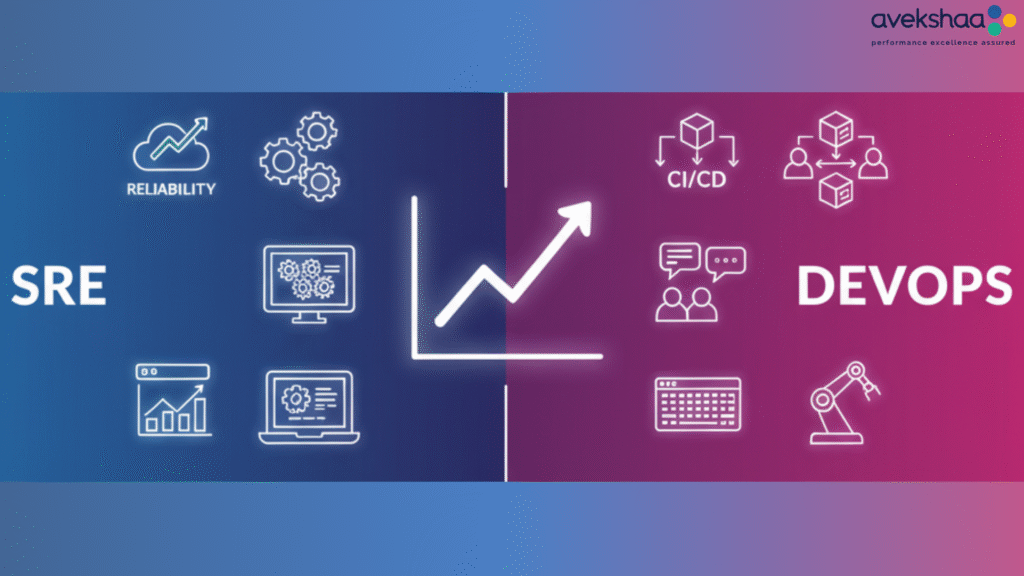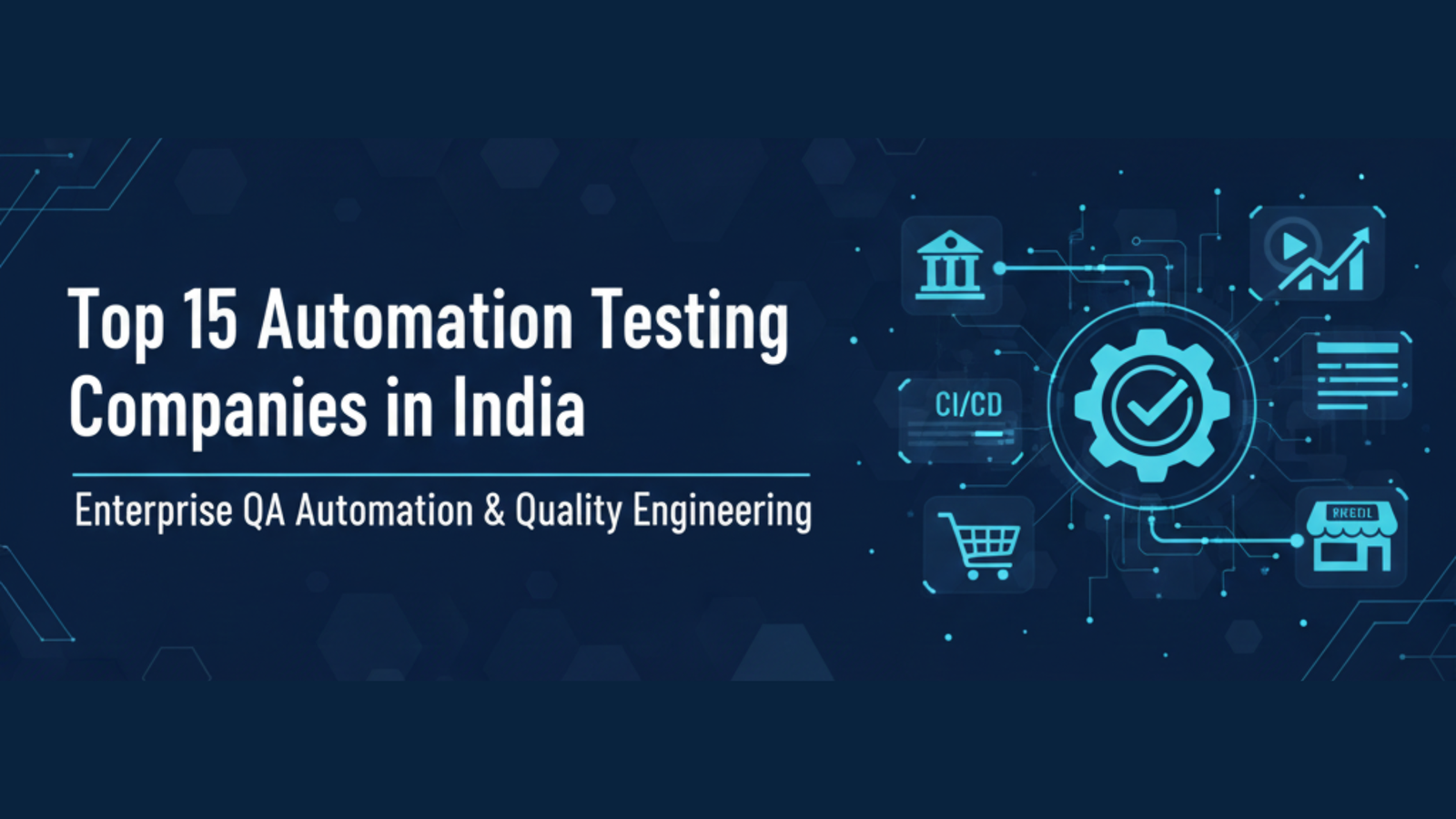Key Takeaways:
- SRE and DevOps are complementary approaches that improve application performance and delivery.
- DevOps focuses on speed, collaboration, and continuous delivery, connecting development and operations teams.
- SRE emphasizes reliability, uptime, and measurable system performance through engineering-driven practices.
- Clear role definitions between DevOps and SRE teams prevent overlap and improve efficiency.
- Automation and AI-powered monitoring are essential for faster releases and proactive incident management.
- SLOs, SLIs, and error budgets help organizations quantify reliability and guide performance improvements.
- Combining DevOps agility with SRE reliability creates scalable, high-performing applications.
- Communication between development, operations, QA, and reliability teams is crucial for seamless delivery.
- Organizations that balance speed with resilience build user trust and long-term digital success.
- Continuous evaluation and improvement of both DevOps and SRE practices are key to sustaining performance at scale.
Introduction
Businesses rely heavily on applications that work seamlessly. Users expect speed, stability, and uninterrupted service. Meeting these expectations requires more than good code; it demands smart processes and structured engineering approaches. That’s where SRE vs DevOps comes into play.
Both are essential in modern software delivery, but they focus on different priorities. DevOps emphasizes speed, collaboration, and continuous delivery. SRE, or Site Reliability Engineering, focuses on system reliability, uptime, and measurable performance. Understanding the differences, roles, and responsibilities of each can help organizations improve application performance while balancing speed and stability.
Did you know, “according to the 2024 DORA (DevOps Research and Assessment) Report, elite DevOps teams achieve a lead time for changes of less than one day, deploy on demand, maintain a change failure rate of 5% or lower, and recover from failures in under an hour.”
What is DevOps?
DevOps is more than a set of tools; it is a culture and a practice. Its goal is to bridge the gap between software development and operations teams. By fostering collaboration and communication, DevOps enables faster software delivery without compromising quality.
Key DevOps Roles and Responsibilities:
- Automating Pipelines: DevOps engineers set up automated CI/CD pipelines that streamline the process of building, testing, and deploying code.
- Infrastructure Management: They monitor and maintain servers, networks, and cloud environments to ensure applications run smoothly.
- Collaboration and Communication: DevOps encourages developers, QA, and operations teams to work together, sharing insights and feedback.
- Performance Monitoring: While speed is the priority, DevOps also focuses on monitoring application health to prevent bottlenecks.
Impact on Application Performance
DevOps improves application performance indirectly by creating fast, repeatable processes. Frequent releases allow teams to identify and fix issues quickly. Automated pipelines reduce human error, and continuous monitoring ensures that minor problems don’t escalate. Users notice the difference when updates roll out smoothly, features work correctly, and applications respond quickly.
What is Site Reliability Engineering (SRE)?
SRE is an engineering-driven approach that focuses on reliability and system performance. Developed at Google, SRE applies software engineering principles to operations. It treats operations problems as code, aiming to automate tasks wherever possible.
SRE Responsibilities Include:
- Ensuring Reliability and Uptime: SRE teams work to make sure applications stay online and available, even under heavy load.
- Defining SLOs and SLIs: Service Level Objectives and Service Level Indicators help teams measure performance objectively.
- Incident Management: When things go wrong, SRE teams respond quickly to minimize downtime and restore services.
- Fault Tolerance: They design systems to handle failures gracefully and prevent cascading issues.
Impact on Application Performance
SRE directly affects reliability, stability, and scalability. By monitoring metrics like error rates, latency, and uptime, SRE ensures users have a consistent experience. Applications can handle surges in traffic without slowing down, and critical failures are addressed quickly. The focus is on long-term performance rather than just rapid deployment.
SRE vs DevOps: Key Differences
What is the difference between SRE and DevOps?
While DevOps and SRE often work closely together, their focus, approach, and metrics differ.
| Aspect | DevOps | SRE |
| Focus | Speed, agility, and collaboration | Reliability, uptime, and measurable performance |
| Approach | Culture-driven, automating workflows, continuous delivery | Engineering-driven, defining error budgets, proactive reliability |
| Metrics | Deployment frequency, lead time, recovery time | Uptime, error rates, latency, SLA adherence |
| Mindset | Move fast, release often | Reliability first, calculated risk |
DevOps encourages teams to release quickly and frequently, while SRE ensures those releases do not compromise the user experience. Together, they create a balance between rapid innovation and reliable performance.
How SRE and DevOps Complement Each Other
It is not about choosing one over the other. DevOps and SRE complement each other to improve application performance holistically.
- Faster Releases with Reliability: DevOps accelerates software delivery. SRE safeguards reliability by monitoring error budgets and managing incidents.
- Continuous Improvement: DevOps provides rapid feedback loops, and SRE helps interpret this data to improve system stability.
- Scalability: DevOps teams ensure pipelines and infrastructure can handle growth. SRE teams design systems that scale under high traffic.
Real-world applications often combine these approaches. Frequent deployments powered by DevOps practices can safely reach production thanks to SRE’s reliability controls.
Practical Ways to Improve Application Performance
Organizations looking to boost application performance can benefit from a combined approach:
- Clear Role Definition: Specify what DevOps teams handle versus what SRE teams manage. This avoids duplication and confusion.
- AI-Powered Monitoring: Use intelligent monitoring tools that detect anomalies and predict potential failures.
- Automation of Repetitive Tasks: Both DevOps and SRE rely on automation to reduce manual errors and free teams for higher-value work.
- Error Budgets and SLOs: Establish clear performance objectives and acceptable error margins to guide decision-making.
- Cross-Functional Collaboration: Encourage communication between developers, QA, operations, and reliability engineers to share insights and best practices.
These practices ensure that application performance is maintained while still enabling rapid feature delivery.
Common Challenges
Even with the best strategies, organizations face challenges when implementing SRE and DevOps:
- Role Overlap: Without clarity, responsibilities may blur, causing delays or missed issues.
- Overemphasis on Speed: DevOps may prioritize fast releases, risking system reliability.
- Excessive Rigidity: SRE teams that focus too heavily on reliability metrics can slow down innovation.
- Tool Gaps: Inadequate monitoring, automation, or performance tools can limit effectiveness.
Addressing these challenges requires a careful balance between culture, engineering practices, and technology.
Conclusion
SRE vs DevOps is not about picking a winner. Both approaches are essential for modern software delivery. DevOps brings speed, collaboration, and agility, while SRE ensures reliability, stability, and measurable system performance.
Organizations that integrate DevOps practices with SRE principles can achieve scalable, high-performing applications. By defining clear roles, leveraging automation, and monitoring key metrics, teams can deliver seamless experiences to users while maintaining uptime and stability.
At Avekshaa Technologies, we help enterprises optimize application performance by combining reliability engineering with modern DevOps practices. With our expertise in performance testing, monitoring, and cloud performance engineering, we ensure your systems deliver both speed and reliability at scale.
The future belongs to organizations that balance innovation with resilience. By understanding SRE vs DevOps and implementing them effectively, businesses can stay ahead, meet user expectations, and confidently scale their digital operations.
Frequently Asked Questions (FAQs)
DevOps is a culture and set of practices focused on connecting development and operations for faster software delivery. SRE, on the other hand, is an engineering-driven approach that ensures reliability and uptime. While DevOps emphasizes speed, SRE prioritizes stability and measurable performance metrics.
DevOps roles involve automating pipelines, managing CI/CD workflows, and monitoring infrastructure. By streamlining processes and reducing human errors, DevOps teams help applications be deployed faster and run more efficiently, which indirectly improves performance.
SRE teams focus on reliability, fault tolerance, incident management, and defining SLOs and SLIs. They proactively prevent downtime, respond to failures quickly, and ensure systems scale smoothly, maintaining consistent performance for users.
DevOps enables faster development and frequent releases, while SRE ensures those releases remain stable and reliable. Together, they balance speed with uptime, helping organizations deliver high-quality applications consistently.
An error budget defines the acceptable level of system failures or downtime within a specific period. It helps SRE and DevOps teams prioritize issues, make informed decisions, and balance innovation with system reliability.
Yes, automation reduces repetitive tasks, limits human error, and speeds up deployment and monitoring processes. DevOps teams automate CI/CD pipelines, while SRE teams automate reliability checks and incident responses to maintain consistent performance.
Service Level Objectives (SLOs) and Service Level Indicators (SLIs) provide measurable benchmarks for system performance, such as uptime, latency, and error rates. These metrics allow teams to track reliability and take corrective actions proactively.
Common challenges include role overlap, overemphasis on speed over reliability, rigidity in reliability processes, and gaps in monitoring or automation tools. Addressing these requires clear responsibilities, communication, and the right technology stack.
AI-powered monitoring can detect anomalies, predict potential failures, and provide actionable insights in real time. This allows teams to respond faster, prevent outages, and maintain consistent performance at scale.
By integrating DevOps agility with SRE reliability, organizations can deliver applications quickly without compromising uptime. This combination improves user satisfaction, reduces risk, and ensures systems can scale effectively as demand grows.


